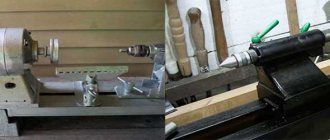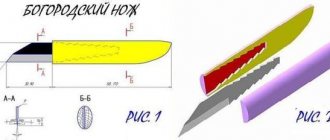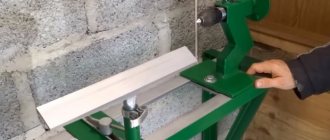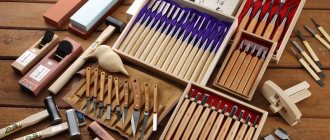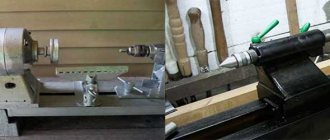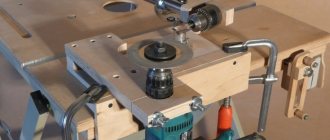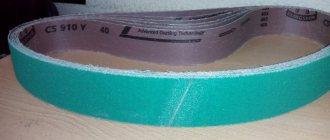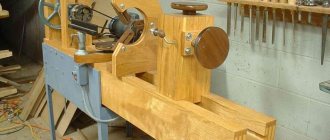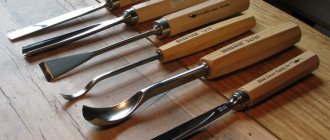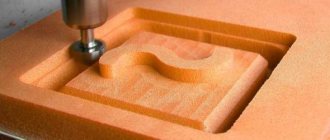The process of wood carving is an exciting hobby. The possibilities for creativity are almost endless, there are many techniques and styles of carving. In order to take the first steps towards this art, you will need a professional tool, and it costs a lot of money. You can make a wood carving tool with your own hands.
For the entry level, a few devices that can be used to apply a design to a wooden surface will suffice. This article will talk about how to make your first wood carving kits. First, you need to decide what woodworking tools for beginners you will need.
Chisels
You can make chisels for wood carving with your own hands if you have a metal blank and a grinder with a sharpening stone. The final sharpening of chisels is done manually, without the use of power tools; after giving the desired shape to the tip, it is necessary to harden it.
The cutting part of the chisel must be hardened after shaping and sharpening the tip. To do this, heat the sharp part of the tool to a crimson color using a gas or kerosene burner and lower it into a container with machine oil or waste.
Advice! Immediately after placing the working part of the chisel in the liquid, move it into the sand, this will save you from the procedure of cleaning the chisel from fuel oil.
The point of a chisel can be straight or shaped; the easiest to make is a straight point; in order to make the right shaped chisel you need to know the proportions.
The handle can be turned on a home lathe, assembled from an engine from an old refrigerator and a corner of different sizes.
Types of chisels for wood carving have different sizes and shapes of the working part; it is expressed in numerical values from 1 to 12.
The curvature of a chisel is determined by the number assigned to it; the smoother it is, the lower the numerical value is used to designate it. Smooth chisels for wood carving are used mainly at the initial stage of processing the workpiece. More V and U shaped curves, numbered 12 and 11 respectively, are used to give the final appearance of the product.
Advice! When making a handle for a chisel, try to make it flatter, this will prevent the tool from involuntarily rolling off the table. When dropped on the working part, it becomes dull and requires frequent sharpening.
Wood carving is done with small chisels, the size of an adult's palm. There are smaller tools available that are used when working with small parts.
Incisors
One of the most commonly used wood carving tools is the cutter. Wood carving cutters should be of various shapes; the set includes a total of six varieties. The types of wood cutters depend on the factors described below.
The difference is the shape of the blade and its angle of inclination; depending on them, the cutter is selected for each specific case. Of the six devices, one is usually considered the main one; most operations are performed using it. Here are some requirements applicable to all types of cutters:
- Convenience - the handle should fit well in the palm of your hand and not have sharp edges so as not to damage your hand during operation;
- Sharpness – the blade should always be well sharpened. To ensure sharpening lasts longer, the blade is made of alloy tool steel.
Sharpening cutters is a responsible and complex process, since sometimes they have a bizarre blade shape.
When buying a cutter on the market or in a specialized store, do not hesitate to pick it up and check whether it will be convenient for you to work with it in the future.
Do-it-yourself sharpening of cutters
The quality of the treated surface largely depends on the correct sharpening of the working tool.
Read also: Ballu convector instructions for use
To do this, you will need an electric sharpening machine with a set of wheels of different grain sizes and a velvet bar for manually editing the blade.
Video of sharpening cutters
Each craftsman chooses the sharpening angle independently, focusing on his skill as a turner, the hardness of the wood, the quality of the working tool and the final desired appearance of the surface being processed.
For a novice turner, the optimal sharpening angle options will be:
- for meisel - the bevel itself should be 40° relative to the axis of the working surface and 40° for each side of the blade;
- for reyer – 50° – 60°.
Over time, as the turner's skill level increases, sharpening angles can be reduced to 20° - 35°.
Ideally, in addition to a set of different styles, it is desirable to have cutters of the same type, the same size, but with different sharpening angles. This will make the turner’s work much faster and easier, and will also extend their service life, because there will be no need to constantly resharpen the blades depending on the type of wood being processed.
Blunt sharpening angles are intended for: hard wood, initial (rough) processing.
Sharper corners of the cutting tool allow for better surface treatment and speed up the turning process, but at the same time there is a high probability of chipping the workpiece and damaging the blade. And such a tool has to be sharpened and adjusted much more often than with more obtuse angles.
The approximate sharpening angle of the blade is formed at the stage of making cutters with your own hands, before the start of heat treatment - hardening.
Then, when they are completely ready, the sharpening process is carried out using an abrasive wheel and is completed by hand finishing on a velvet block.
If you find an error, please select a piece of text and press Ctrl+Enter.
At all times, the profession of cabinetmaker was not only in demand, but also very prestigious. In the modern world, the ability to make beautiful, multifaceted products has already gone beyond the scope of an ordinary hobby and brings good financial income to craftsmen. With the help of wood carving you can obtain high-quality artistic products (for example: boxes, picture frames, furniture). But in order to be able to do such an interesting and exciting business, you must always use special tools.
After all, it is professional wood cutters for manual work that allow you to carry out any type of wood processing: trimming, sawing, splitting, chiseling, planing, turning and even applying figured carvings.
Knives
When working with wood, you cannot do without a good knife; when choosing this tool, you should give preference to the one that will be most convenient for processing wood. It is also important to find out what grade of steel was used in its manufacture.
When choosing a knife from a foreign manufacturer, you need to compare the specified steel grade with a domestic analogue, and check what properties it has according to the steel grade.
A good knife is characterized by a high carbon content with the addition of alloying elements.
Knives for working with wood are divided into three types: folding, with a replaceable and fixed blade. A blade with a length of 40 to 50 mm and a thickness of 4 mm is considered optimal.
Wood carving for beginners
In order to master the skill of turning objects from ordinary wood into works of art over time, you need to gradually go through lessons, moving from simple to complex.
To learn how to create decorative wooden elements, you need to know the technology of work and possess the necessary tools, without neglecting safety precautions.
Masters advise beginners, especially children, to first master the basics of contour carving. For it you will need:
- wooden canvas or object for decoration;
- set of chisels;
- blunt knife;
- pencils;
- sketch (drawing);
- sandpaper.
First, using a sample, you need to check how to work with each of the chisels, see what it is needed for, and practice.
Then the sketch from the paper needs to be transferred to the workpiece.
Only after studying the basic principles of working with the tool can you proceed to testing the products.
The most common are sketches with images of flora and fauna, and landscape sketches.
After applying the pattern, the wood must be sanded and varnished.
Power tools
Wood carving involves manual processing, but at the initial stage it is possible to use power tools for wood carving. These include:
- Electric jigsaw;
- Drill;
- Lathe;
- Electric planer.
Preparatory stages involving additional equipment are needed to give the workpiece the necessary proportions for further processing using hand tools.
A wood carving workshop should be equipped with a standard set of power tools.
Types of incisors
It is generally accepted that a true master needs one or two tools to work, which also include wood cutters for a lathe. But practice shows that you can achieve the best results and simplify the work only with the help of a full set of devices, which includes a chisel with different blades. Experts in this field advise acquiring the following tools:
- Jamb cutters are a type of tool with small, triangular-shaped blades. Such handmade wood cutters can have different bevel angles, which allows you to create patterns of complex configurations. These versatile cutters consist of three parts: the heel, the toe and the blade itself;
- Chisel cutters are considered the most popular cutting tool. Chisels come in semi-circular, angle, flat, reverse and bracket types. This set allows you to create various recesses and grooves, as well as create one or another surface texture;
- cranberries are tools for finishing that have a curved working area that allows you to create clear contours of certain elements;
- Spoon cutters have a ring or semi-ring shape. They are designed for cutting spoons. Often, cabinetmakers make such cutters themselves and adapt them to their own needs.
There are also additional devices that are used by carpenters. These include planes, jigsaws, grinders and other electrical and mechanical tools, which can also be of different configurations. For example, there are bow and saber hacksaws (for finishing and rough work, respectively).
Specialists dealing with large-sized structures often use figured adzes (hatchet cutters). Novice craftsmen are not very versed in the types of tools, so it is important for them to adhere to one simple rule - quality comes first. Due to the fact that high-quality knives are quite expensive, some people make cutters on their own. In addition, you can now find relevant instructions online.
Making a knife
There are a huge number of options for making knives yourself; let’s look at the most popular of them.
Blade knife from a hacksaw for metal
A broken or sharpened blade is suitable for such a knife. The process of processing it is quite complicated, this is explained by the high quality of the steel, but on the other hand, the better the tool will be.
Using a grinder, cut the blade into three parts at an angle of 45 degrees, this angle will be the working surface of the future knife.
The grinder accelerates to high speeds during operation, which will affect the quality of the metal; all alloying elements near the cut will simply burn out. Therefore, after sawing, you will need to clamp the desired part of the blade in a vice and use a file to remove two or three damaged millimeters.
If the blade is too thick, then it is recommended to remove excess metal with a small file or needle file. Sharpening a wood carving tool requires a thorough approach; this will require a needle file and sandpaper.
When the sharpened cutter is ready, you can think about the handle. The easiest thing would be to simply wrap it with electrical tape or raw rubber, but professionals prefer handles made of wood.
Attachments and accessories for sanding wood
Discussion: 31 comments
- Matvey:
10/09/2011 at 11:57 amVery clear and understandable!!! THANKS A LOT!!! and then they say... he took it and did it, but here everything is clear.... I wish I could tell you more about making a pen...
Answer
admin:
10/10/2011 at 10:58 am
Good wood cutters also require a good handle. See how to refine and polish them in another section.
Answer
10/10/2011 at 11:02 am
Section: wood processing, post attachments and sanding devices.
Answer
- Andrey:
08/13/2014 at 12:42 pm
Good afternoon ! Try to release the metal, (an old recedevist told me this) put metal into a plugged pipe at one end (from which we will make a knife) and fill it with sand, jam the pipe from the other end. Then we put it in the oven, this device should cool in the pipe. After this we cut the pipe. Metal will not crumble and will not be so brittle
Answer
10/18/2011 at 6:56 pm
I would like to buy this cutter that you made from a metal cutter. Would you sell this cutter?
Answer
12/22/2011 at 1:38 pm
funny information. A cutter from a milling cutter, a chisel from a punch, a cranberry, for example, from an old crankshaft......Well, firstly, cutters are not made of carbon steel at all. This is high-alloy steel of the R6M5 type. With carbon steel, hammers and files. The hardness of the cutter is 60HRC and it will not make a normal cutter. If you do normal sharpening, the cutting edge will constantly chip, and this is not a thread, but fidgeting. Proper heat treatment of high-speed steels such as R6M5, R18, etc. Not every blacksmith can do this. And the product will either turn out to be a good miniature cleaver, or a headache and calloused hands. In world practice, only turning wood cutters are made from high-speed steel, and even then in Japan. They weld a cutting edge 10 millimeters wide and that’s it. Alas, it’s an axiom that for normal incisors, normal iron…..With great respect for the homemade ones. Alexander Korneev.
Answer
- admin:
12/23/2011 at 5:44 pm
Thank you for your comment Alexander! But unfortunately or fortunately, I don’t know the markings of the cutters, I just take it and try it. By the way, this idea was given to me by professional cabinetmakers and I trust their experience because they work every day. But there is some truth in your words, really, You shouldn’t make cranberries from a crankshaft. And thank you again for the detailed information, since it also has a basis and experience.
Answer
01/30/2013 at 8:44 am
Alexander, are you a professional carver or are you just spinning around this topic. I have been working as a carver for 16 years, 10 of them professionally. I made all the tools for myself from metal cutters, this is an ideal steel for chisels. And when I read about what the cutter doesn’t fit, then I see first of all an amateur (sorry if I’m wrong).
Answer
12/25/2011 at 9:41 am
A huge hello to fans of R6M5 and other heat-resistant steels. The only advantage of this iron is the ability to make a cutter at home without heat treatment. For some it is out of poverty, for others out of greed, the third director is his own. It also happens from communicating with Tatyanka girls. I’m far from an amateur, I’ve been making cutters for over 30 years, I’ve tried a lot of steels, including. all kinds of exotics. And I came to the conclusion long ago that nothing better has been invented than the steels originally created for woodworking. Competent heat treatment according to the requirements. parameters and in the hands of a tool with a capital letter. But you will agree that heat-resistant steel is for metal processing and you won’t see a sharpening angle of less than 45 degrees on any product. It’s durable, but alas, it’s fragile. And this defect cannot be treated at home. However, not only .. Have you ever seen a branded wood cutter made of similar steel. Or a hunting knife or any serious one. Alas... But the bourgeoisie is not almost more stupid than us, even with his eternal thirst for profit. To Caesar is what is Caesar’s, and to Korneev what is rooted to Korneev. Sorry for the pun, time to get to work.
Answer
- admin:
12/25/2011 at 1:16 pm
Well then, bring it to the point. Where are such tools sold, how much do they cost and what markings are there to recognize. If something is prohibited, then something must appear in return, otherwise stupor. I’m waiting for an answer. With deep respect to all masters!
Answer
11/12/2020 at 12:06 pm
But what about Adolfa Yuryev and the STRY company? They make cutters from P6M5 and P18 and their products are quite good.
Answer
12/26/2011 at 4:26 am
Hello everyone. My instrument is for sale at Vernissage from Victor Kuznetsov. You can also buy it in the Wood Carving online store. You can also order directly from the manufacturer. I live and work in the Khabarovsk Territory. So if you want to call, don’t wake me up at night. It’s a seven-hour difference from Moscow. So call, write, draw. Price from 200 rubles. and up to 500. These are chisels for park and ice sculpture and other manifestations of gigantism. Ordinary incisors, incl. turning 200 350 per unit. A set of 16 cutters costs 3 tr. There will be no show-offs like Tatyanka or a stayer. Just normal cutters made from quality metal. My email address My phone number is 89622284274.
Answer
07/26/2012 at 10:38 am
Still, the author used a cutter made of carbon steel or 12ХНЗ. As you can see in one of the photos, when cutting metal, the sparks are dense and yellow. How did Alexander not notice this, who, in his words: “I’m far from an amateur, I’ve been making cutters for more than 30 years, I’ve tried a lot of steels, including. all kinds of exoticism,” it’s not clear. Steel R18—dark crimson sparks with a yellow-red tuft at the beginning, small branches at the ends of two or three threads, with light yellow grains at the ends of the tuft. At the beginning of the spark there is a bright red beam from the touch of the workpiece to the abrasive wheel. (R6M5 also never gave yellow sparks during processing) Such messages strongly remind me of advertising. And the arrogantly boorish tone of Alexander’s messages is not clear to me at all. I hope these messages will not discourage people reading this topic from making their own instruments. Regarding the fragility of the quick cutter, this is completely nonsense. Here are its (P18) characteristics: Steel has a reduced tendency to overheat during hardening, good VISCOSITY, good wear resistance, increased grindability. This is not a file from U8-U10A! For example, Gusarchuk D.M. (a master of artistic three-dimensional wood carving), writes in his book that his best tool is made from a quick cutter. And one more thing: steel ALWAYS has a brand (name), there are GOST standards (for example GOST 5632-72), but for some reason I have never seen “steels originally created for woodworking” anywhere... For reference: in the USSR, good chisels were produced in Leningrad, from U10A steel, but R6M5, R18 and the like were not used because of their high cost and complexity of processing. Actually, this is why the zealous Japanese “Weld a cutting edge 10 millimeters wide and that’s it”... All the data described above is taken from reference literature on metalworking, so if you wish, you can read it all yourself. And the article is very good and useful!
Answer
- admin:
07/27/2012 at 8:58 am
I address you with GREAT gratitude, Nikolai! I didn’t have enough arguments to answer that master, and I don’t think I should. Maybe he understands something, in any case, I also looked for it at one time and share my skills with people. Good luck to you!
Answer
07/30/2012 at 10:09 pm
Good afternoon, thanks for the excellent site, will you tell me if using a metal cutter does not “burn” for cooking? Please tell us in more detail about how not to burn the metal at the stage of shaping it.
Answer
- Nikolay:
08/02/2012 at 11:51 am
If you are sure that you have a workpiece made of P18 in your hands, you should take into account its remarkable features: when heated to ~600*C (dark red glow), this steel retains its properties. If the workpiece is made of U8-U10 (an old file, for example), then in order not to burn the workpiece: 1) Reduce the speed of the sharpening stone + keep a jar of water near the sharpener, where we cool the workpiece as often as possible. We do the final finishing of the chamfers on a coarse-grained block. The block must have a soft binder and be coarse-grained. 2) If possible, use a water sharpener (this is one that has a very low speed and the lower part of the stone is in the water). It is especially easy to burn the tip of a knife, so when sharpening the tip, reduce the pressure on the workpiece and often cool it in water.
Answer
admin:
08/03/2012 at 10:12 am
You need to know all these nuances so as not to spoil the instrument. If possible, we tell people. And I thank knowledgeable people who do not hide their practical skills. I advise beginners to read these tips, they are very valuable!
Answer
08/03/2012 at 2:52 pm
When cutting a workpiece with a grinder, in order not to burn the workpiece, I do not cut the workpiece with an abrasive wheel, but with light pressure I gradually select the metal along the contour previously drawn on the workpiece. If the grinder has a speed control, reduce the speed of the cutting wheel. So, without haste, you get a workpiece of the shape you need and do not “burn” its edges. To make a tool, it is good to take old, still Soviet, metal saws (for a mechanical saw), broken drills (by selecting a semicircle in the shank with an angle grinder, you get a semicircular chisel. Only drills made from a quick cutter will not work - the shank of the drill is not hardened, and a quick cutter can only be properly hardened an experienced thermal operator.), Old taps are almost ready-made semicircular chisels - you just need to sharpen them on a grindstone, the bearing race is a spoon cutter (it is advisable to choose a race with the letter U in the marking), etc. I recommend the Soviet instrument because in those days GOST standards were strictly adhered to. Now a sheet of metal of the same brand can have different Rockwell hardness in different places.
Answer
07/31/2012 at 4:15 pm
Good afternoon everyone! A set of 16 incisors from Alexander recently costs 4,800 rubles (this is about “some from greed, and some from poverty), and the manner of comments is most likely from upbringing and ethical standards, or maybe from the beginnings of “stardom”. I wish you success and “humanity”
Answer
08/04/2012 at 12:11 pm
Cutters and chisels. For cutters, I also tried many steels and also came to the conclusion that the best steel of the available options is metal cutters. I also tried high-speed steel R-18, a very good edge when cutting, but you can’t lean on it - it chips. For impact loads at a flea market I bought Soviet chisels made of high-alloy steel - 9 HF and 9 HS, scraped spoons out of them with an emery grinder, and did this in winter, in severe frosts, so that the steel would not turn blue, (natural cooling, although moisturized) in the garage, polished with flap drums clamped into a pneumatic drill. In wooden planes I also found knives with the steel marking 9 hf, used for small cutters, successfully. Good results with medical steel - a surgical instrument, perfectly withstands shock loads.
Answer
- admin:
08/04/2012 at 8:09 am
I very much agree with you on many aspects. I also tried a lot of different options, but mostly acted blindly, without knowledge of steel markings. Thank you for the addition!
Answer
08/27/2012 at 2:07 pm
Everything is great, of course, but it’s too labor-intensive, I found a simpler solution. I may not be the discoverer, but that's the idea. The task is to purchase (approximate cost 50 rubles) a feather drill (the range of sizes in width is large from 10, etc.) and sharpen it for a jamb. The steel is decent and there is no need to be tricky. I tried it in geometry, which is in no way inferior to the material from a hacksaw and a circular disk.
Answer
01/10/2013 at 5:10 pm
Yes, I use quick cutters, but not impact ones, I’m very pleased. U10 and U12 steel is good for wood. requires hardening after processing. rough sharpening anneals it. good luck to you
Answer
02/25/2013 at 10:10 am
I rarely do carving and, so to speak, “amateurishly,” but I still have knives from the milling cutter from 1999. The teacher made these knives for us at the Criminal Procedure Code after weeks of testing purchased knives. Of course, I have never used a professional tool, but 14 years for knives (even if not used so often) is a pretty decent time. The knives, of course, have already become sharpened from finishing with the “zero” (that’s why I came to this topic), but they still cope with their job quite successfully. So the topic is quite relevant, in particular for me, since only Chinese “crafts” can be found on sale here, and I don’t want to order “somewhere out there” - I need to feel the instrument before buying. In addition, the experience of using cutter knives is quite satisfactory.
Answer
- admin:
02/25/2013 at 5:53 pm
Today I work, one might say more, with jewelry carvings, where everyone is not only mm. but the micron also matters. And all the tools that I have posted on the site have been helping me with this for several years now. But as you noticed, not everyone believes in this, they say you can’t use cutters for metal as much as possible; they have to cut metal. But that’s the way my character is structured, it’s not that I’m against it, but until I check it myself, I won’t believe it. And I'm happy with the quality. I repeat once again that this is not the first year I have been doing this. I agree there are better options, but so far I’m quite happy with tools made from metal cutters. And here many practitioners support me.
Answer
09/15/2013 at 7:02 pm
I haven’t tried making cutters from a metal cutter, but I think the metal is quite suitable. He made his homemade cutters and chisels from the planer knives of a woodworking machine. They are dumb, of course; you have to constantly sharpen them, but well-sharpened and polished ones cut wood very well. I also liked the steel from an ordinary kitchen knife, which was made in Germany. Great stuff! For several years I have been using a cutter made from its fragment and I am amazed at the real German quality. )))
Answer
03.12.2013 at 12:00 pm
It doesn’t say anything about the handle of the cutter, since each cutter makes it himself according to his own hand!!!
Answer
08/08/2015 at 6:05 am
I don’t do carving myself. My uncle is a woodcarver, since the days of the USSR. Almost all the tools are homemade. Files, needle files, saws from woodworking machines, bearings, old chisels, etc. In his opinion, bearings are the most interesting material for making carving tools .The fine structure cuts perfectly, holds an edge for a long time. My experience; I made a chisel knife myself (steel 8Х6НФТ, a jointer knife) based on the Swedish Bahko knife, the sharpening angle of the chisel is 20 degrees. The sharpening angle of the chisel is 20 degrees. The knife is 40 degrees. They complement each other in removing layers of wood. It works perfectly: knife-chisel-chisel. Made from U8A carbon ( LMZ chisels) are very good. (There are about a dozen) The viscosity is pleasant and holds an edge. A quick cutter on wood works worse (I have a knife on a joint made from a mechanical saw) I bought a couple of cutters from HSS and P6AM5. I need to try to make chisels with them.
Answer
11/07/2015 at 8:45 pm
Good afternoon everyone. Personally, for the occasion, I made cutters from knives from a printing machine that cuts paper. True, the thickness is decent, it takes a long time to cut, but the result is excellent.
Answer
12/30/2015 at 12:04 am
please tell me the HSS circular saw is suitable for making cutters since I am in Italy, the steel markings are different there and it is not possible to look for a suitable material
Answer
- Sergey:
02/11/2019 at 3:19 pm
Yes, you can make cutters from HSS steel. I made a metal cutter from P18, a lot of cutters. Sharpening is hard, grinding is easy. The steel is tough, but the knives do not become dull for a long time.
Answer
